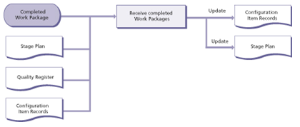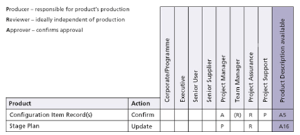PRINCE2 2009 - Controlling a stage part 8
of the Cabinet Office under delegated authority from the Controller of HMSO.
Activities
Review the stage status
If the project is not checked on a timely basis, there is a danger that it will get out of control.
There needs to be a balance between planning ahead and reacting to events.
In order to make informed decisions and exercise rational control, it is necessary to compare what has actually happened with what was expected to happen and what might happen next (including any issues and risks).
It is therefore essential to have a steady flow of information that provides an overall view of progress and simple, robust monitoring systems to supply that information.
The objective of this activity, therefore, is to maintain an accurate and current picture of progress on the work being carried out and the status of resources.
This activity occurs at a frequency defined in the Stage Plan, may be triggered by Project Board advice, or forms part of the analysis of new issues and risks.
Diagram 1 shows the inputs to, and outputs from, this activity.
Diagram 1
PRINCE2® recommends the following actions:
- Review progress for the stage:
- Review Checkpoint Reports for the period
- Review the current Stage Plan forecast and actuals
- Request a Product Status Account from Project Support to identify any variation between planned progress, reported progress and actual progress
- Check for any quality issues shown in the Quality Register
- Check the Risk Register for any new or revised risks and assess their impact on the Business Case, Stage Plan or the Project Plan
- Check the Issue Register to see whether anything has happened within the project or externally that will impact on the Business Case, Stage Plan or the Project Plan
- Check the status of any corrective actions
- Assess the utilization of resources in the period under review and their availability for the remainder of the stage (or project). Check for any variation in the expected future resource availability
- Check the Benefits Review Plan to see whether any benefits reviews are due, and execute them as necessary
- Based on the above analysis, decide whether any actions are required. For example, whether to:
- Authorize a Work Package (see section elsewhere)
- Report highlights (see section elsewhere) in accordance with the Communication Management Strategy
- Capture and examine issues and risks (see section elsewhere)
- Escalate issues and risks (see section elsewhere) if tolerances are threatened
- Take corrective action (see section elsewhere)
- Seek Project Board advice (and if necessary provide them with the Issue Report)
- Log any lessons that have been identified
- Continue as planned
- Revise the Risk Register and Issue Register as necessary
- Update the Stage Plan if the aggregated assessment changes any forecasts
- If ownership of any of the products is to be transferred to the customer as part of a phased handover:
- Request a Product Status Account for the release being handed over
- Ensure that the:
- Products have been approved by those specified in its Product Description
- Products meet all the quality criteria, or are covered by approved concessions
- Operation and maintenance organizations are ready to take responsibility for the products
- Hand over the products (see the section covering ‘Closing a Project’)
- Consider whether to review lessons now or wait until a later review of stage status or when approaching a stage end
- If the end of the current stage is approaching (as indicated by, for example, the Stage Plan, the contents of the Quality Register, a milestone etc.), prepare for the next stage (see the section covering ‘Managing a Stage Boundary’)
- If the end of the final stage is approaching, prepare to close the project (see the section covering ‘Closing a Project’).
Diagram 2 shows the responsibilities for this activity.
Diagram 2
PRINCE2® is a Registered Trade Mark of the Office of Government Commerce in the United Kingdom and other countries.
Managing Successful Projects with PRINCE2 - 2005 edition
Managing successful Projects with PRINCE2 – 2009 edition
Directing Projects with PRINCE2.
plus:
The Complete Project Management package.
And much more besides - at a fantastic price.





